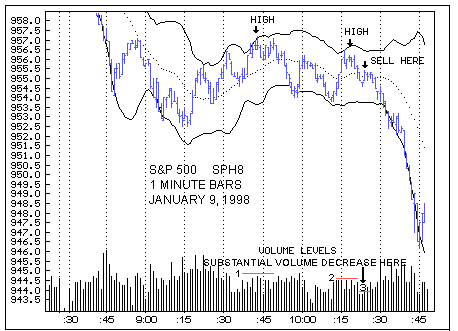Knowing What Indicators to Monitor
In order to profit trading the S&P 500, it is mandatory for
us to know which indicators to monitor. The successful pit
traders watch the Dow Jones Industrial Index, the TICK, the S&P
500 Cash Index, the Dow Transports, certain selected stock issues,
and the Intraday Highs and Intraday Lows. Since they're the trading
group that substantially moves the very short term market, it is
incumbent upon us to also follow these same indicators. The
following is a description of each indicator:
Dow Jones Industrial Index (INDU). The Dow Industrial
Index is a composite average of the 30 leading stocks. As a generalization,
the Dow and the S&P 500 frequently move together, though under
some market conditions, this does not occur.
The TICK (TICK). This indicator tells us the difference
between advancing and declining stocks. For example, a reading
of -26 means there are 26 more declining stocks than stocks that
are advancing. TICK values before 9:30 Central are frequently
misleading and it is generally a good idea to ignore this indicator
unless extreme values of +/- 700 are recorded.
The TICK may lead futures; at other times, the TICK may act
as a lagging indicator. Additionally, the rate-of-change of TICK
can give us valuable information about price direction.
The S&P 500 Cash (SPX). The cash index is the market
since cash is calculated as an average of all 500 stocks comprising
the index. This calculated cash index value differs from the
S&P 500 futures value because the cash is calculated about every
minute, whereas the futures can change instantaneously whenever
a bid or ask price gets hit in the pit. This difference in cash
and futures is called the Premium.
The Premium is an important concept and is covered in another
section of the S&P Corner. The importance of the Cash S&P
is that the futures prices must ultimately follow the cash prices.
Dow Transports (TRAN). This index usually acts as an excellent
leading indicator. When the Transports diverge with the Industrials,
values usually follow the Transports.
Selected Stock Issues. Certain stocks may lead the S&P
Futures under certain market conditions. Historically, IBM
(IBM) leads futures. Other stocks which lead futures can be
General Electric, Intel, and General Motors. Which stock or stocks
have a predictive ability changes day-to-day and can only be determined
empirically.
Intraday Highs and Intraday Lows. Most floor traders
want to take the market to areas where stops are located so that
they can scalp those values. Where are the stops located?
The answer is above the intraday high, below the intraday low, and
above and below any nearby support or resistance. The market
has an affinity for those areas where stops are located. What
you need to do is observe what happens to the market when price
reaches these stops. Questions to ask are:
- Does the market go dead?
- Do prices take off higher; quickly or slowly?
- Does the market stay down?
The move away from the stops may be a valuable clue to future market
direction. As a valuable exercise, use the Support/Resistance
section of the Overnight Update and attempt to locate the probable
location of stops. Realize the current intraday highs and intraday
lows should also be included in your evaluation.
Now follow price as it approaches those areas you have identified
as "stop bands". Then follow price movement away
from the bands. Once the intraday high has been made and stops
placed, the market will attempt to return to that level to hit those
stops.
Volume is the principle fuel of the markets. The market may
not revisit those highs again but if it does and the volume drops
substantially, the market can only go down. The converse is
true of bottoms.
|



 There
is a risk of loss in futures trading.
There
is a risk of loss in futures trading.